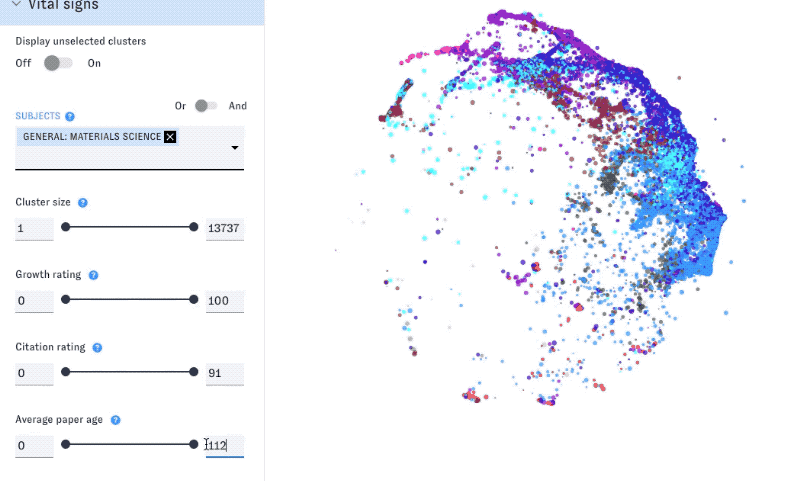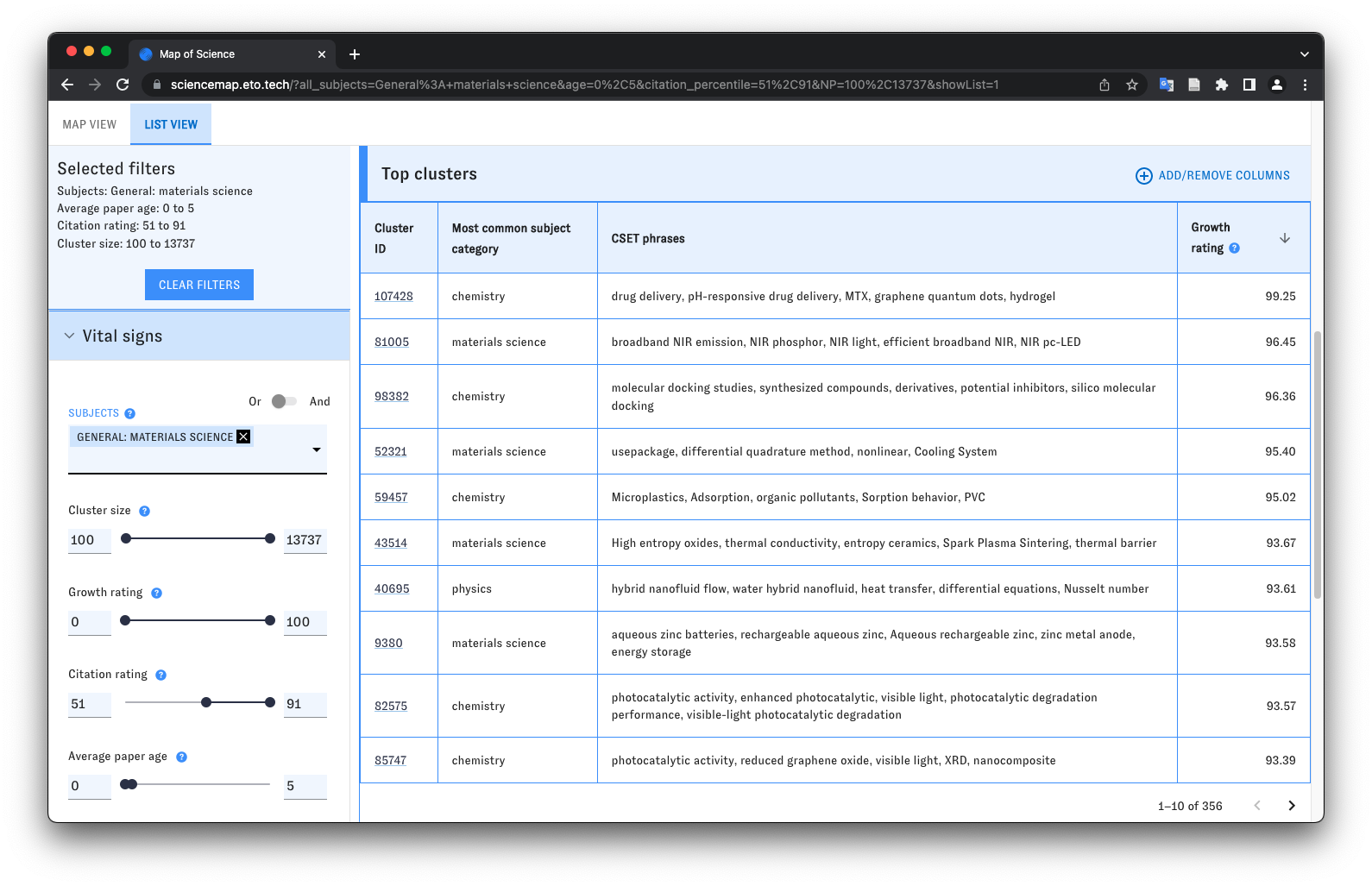When we built the Map of Science, we wanted to give users of different backgrounds, resources, and analytic perspectives a genuinely accessible way to explore global research. To achieve our mission, we combined powerful methods for combining, processing and enriching hundreds of millions of research articles with a flexible, intuitive interface that’s free for all to use.
The Map of Science helps users quickly find specific areas in science and tech that matter to them, starting from broad questions like:
- Which topics are growing fastest?
- Which types of research are having the biggest impact?
- What are researchers in a particular country most interested in?
The Map can help you get a handle on questions like these - all without a team of experts or a multimillion-dollar budget.
This post is the first in our “Hot Topics” series, which shows how you can use the Map to uncover and explore emerging topics in many different STEM fields. True to our mission to make science and tech insights more accessible, all of the research described in this post was done using the Map of Science only, in less than an hour, by one non-expert analyst (your narrator).
-9ea2db32ff242cc402be4e5115855274.png)
To kick off the series, we’ll use the Map to uncover hot topics in materials science, a diverse field of research that has attracted huge attention and public investment in recent years. We’ll begin by selecting the general “materials science” subject from the filter pane. This will focus the Map on clusters with a significant number of articles related to materials science, as determined by our subject assignment model. (Research clusters, the basic unit of the Map, are groups of articles that cite each other a lot - read more here about how they work.)

To find some especially interesting areas of research in these results, we’ll filter down to relatively “young” clusters (with an average article age of five years or fewer) with a large number of recent articles (100 or more in the last five years). Finally, we’ll look only for research that gets cited frequently (defined here as a higher citation rate than the median across all of the clusters in the Map).

Switch over to the Map’s list mode to view our results, sorted here by growth rating.

A few minutes browsing the very fastest-growing clusters points to many interesting topics for follow-up research, like these:
| Cluster ID | What does this cluster seem to be about? (summary based on the cluster's keywords and top articles) | Number of articles (last 5 years) | Selected articles (selected from the "Articles and sources" pane in the cluster's detail view) | Other interesting features (based on information from the cluster's detail view) |
| 9380 | Zinc-ion batteries | 3620 | "Active Materials for Aqueous Zinc Ion Batteries: Synthesis, Crystal Structure, Morphology, and Electrochemistry" | Average article age is less than two years old; nearly 10 times as many Chinese-authored articles as U.S.-authored articles, but the U.S.-authored articles are cited about twice as often on average |
| 107248 | New uses of natural materials for pH-sensitive drug delivery - chitosan, alginate, graphene oxide, etc. | 102 | "pH-sensitive drug delivery based on chitosan wrapped graphene quantum dots with enhanced fluorescent stability" | Extremely rapid growth (99th percentile) |
| 43514 | High-entropy ceramics and their applications | 1002 | "Processing and Properties of High-Entropy Ultra-High Temperature Carbides" | Top three author institutions: Chinese Academy of Sciences, Oak Ridge National Laboratory, and Northwestern Polytechnical University (a Chinese military-affiliated university) |
| 48593 | Nanoparticles that fight viruses | 850 | "Functional Carbon Quantum Dots as Medical Countermeasures to Human Coronavirus" | 75 patents cite articles in this cluster (90th percentile among all clusters in the Map) |
| 81005 | Phosphors in near-infrared light sources | 341 | "Highly efficient and thermally stable Cr3+-activated silicate phosphors for broadband near-infrared LED applications" | 81% of the most recent articles (276/341) have Chinese authors |
| 2531 | "MXenes" (two-dimensional materials with unusual properties) - synthesis and application | 4461 | "Applications of 2D MXenes in energy conversion and storage systems" | Drexel University (Philadelphia, PA) leads the authorship table (267 articles in the last five years, 30.37 citations per article), followed by the Chinese Academy of Sciences (221 articles, 14.3 average citations per article) |
| 54445 | Using lasers to make graphene | 670 | "Laser-induced graphene for bioelectronics and soft actuators" | Frequently cited by articles in other clusters related to wearable sensors and alternative energy |
| 55310 | Transparent engineered wood | 664 | "Bioinspired Wood Nanotechnology for Functional Materials" | Top author countries: China, U.S., Sweden, Switzerland, Germany |
| 14501 | Hydrogel-based sensors with interesting properties | 2143 | "Mussel-inspired hydrogels as tough, self-adhesive and conductive bioelectronics: a review" | 57% (1216/2143) of the articles in this cluster were funded by China's National Natural Science Foundation |
To explore these results for yourself, click here to run the same search in the Map of Science. (Pro tip: as you use the Map, your browser’s URL bar updates to reflect your selected filters and views.) Check back soon for the next posts in our series, where we’ll move on from materials science to tour the leading edges of research in other fields.

